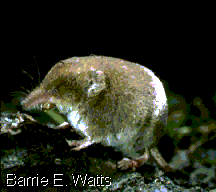
|
Robb's On-line Multimedia Database of Animals & Plants |
|
-Robb's Biology Books |
Subclass Placentalia (Placental Mammals)

Common Shrew (Sorex araneus)
Source: Microsoft® Encarta® 96 Encyclopedia
Please do not plagiarize.
If you would like to use this information in a print or electronic publication, please ask me for permission first and cite this page as:
Knapp, Robbin D. 1999.
"Subclass Placentalia (Placental Mammals)".
In Robb's Online Multimedia Database of Animals and Plants.
Dec. 19, 1999.
Orders of the Subclass Placentalia (Placental Mammals)
- Insectivora (insectivores, including small mammals such as moles, shrews, tenrecs, and hedgehogs)
- Dermoptera (the colugos, or so-called flying lemurs)
- Chiroptera (chiropterans, the bats)
- Carnivora (carnivores, including the cats, viverrids (civets and mongooses), dogs (including wolves, foxes, and coyotes), hyenas, raccoons, bears, and mustelids (weasels, martens, otters, badgers, and skunks), seals, sea lions, and walrus)
- Macroscelidea (the elephant shrews)
- Primates (primates, "first or primary animals", including the tree shrews, lemurs, lorises, tarsiers, monkeys, apes, and humans)
Suborders:according to Hershkovitz (1977) - Strepsirhini
- Haplorhini
Infraorders:- Tarsii
- Platyrrhini
 Catarrhini
Catarrhini
according to Simpson (1945) - Prosimii
Infraorders:- Lemuriformes
Superfamilies:- Tupaioidea
- Lemuroidea
- Daubentonoidea
- Lorisiformes
- Tarsiiformes
- Lemuriformes
- Arthropoidea
Superfamilies:- Ceboidea
- Cercopithecoidea
- Hominoidea
according to Romer (1966) - Lemuroidea
- Tarsioidea
- Platyrrhini
 Catarrhini
Catarrhini
Superfamilies:- Cercopithecoidea
- Hominoidea
- Xenarthra (including armadillos, sloths, and the three anteaters of the Americas)
- Pholidota (scaly anteaters, the pangolins)
- Tubulidentata (aardvarks)
- Rodentia (rodents, including squirrels, beavers, pocket gophers, pocket mice, rats, mice, mole rats, dormice, jerboas, porcupines, guinea pigs, and chinchillas)
- Lagomorpha (including rabbits, hares, and pikas)
- Sirenia (sea cows, including the manatees and dugong)
- Cetacea (cetaceans, the whales and dolphins)
Suborders:- Odontoceti (toothed whales)
- Mysticeti (Mystacoceti, baleen whales)
- Hyracoidea (hyraxes)
- Artiodactyla (even-toed ungulates, including pigs, hippopotamuses, camels, llamas, chevrotains, deer, giraffes, the pronghorn, cattle, antelopes, goats, and sheep)
- Perissodactyla (odd-toed ungulates, including horses, rhinoceroses, and tapirs)
- Scandentia (the tree shrews)
- Proboscidea (elephants)
King Philip Chews on funny ginger snaps.
Sources:- Corbet, Gordon & Denys Ovendon. 1980. Pareys Buch der Säugetiere. Parey: Hamburg. 240p.
- DeBlase, Anthony F. & Robert E. Martin. 1981. A Manual of Mammalogy. Wm. C. Brown: Dubuque, Iowa. 436pp.
- Haensch, Günther & Gisela Haberkamp de Antón. 1981. Wörterbuch der Biologie. BLV: Munich. 680pp.
- Haltenorth, Theodor & Helmut Diller. 1980. A Field Guide to the Mammals of Africa Including Madagascar. Collins: London. 400pp.
- Microsoft Corporation. 1996. Microsoft® Encarta® 96 Encyclopedia.